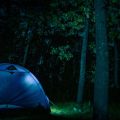1. Understanding Group Campsite Basics
When planning a camping trip with friends, family, or an organization, choosing a group campsite is usually the best option. In the U.S., national and state parks offer special group campsites designed for larger gatherings. Understanding what sets these sites apart from standard or individual campsites can help you make the right choice for your group adventure.
What Are Group Campsites?
Group campsites are designated areas within campgrounds that are specifically intended to accommodate bigger groups—usually ranging from 10 to 50 people or even more. These sites are perfect for scout troops, school outings, family reunions, church groups, or any event where multiple tents and vehicles will be needed.
Typical Features of Group Campsites
Group campsites differ from standard campsites in both size and amenities. Here’s a quick overview of what you’ll usually find:
| Feature | Group Campsite | Standard/Individual Campsite |
|---|---|---|
| Capacity | 10-50+ people | Usually 1-6 people |
| Tent Pads/Spaces | Larger area for multiple tents | Space for 1-2 tents |
| Picnic Tables & Fire Rings | Several provided for group use | One per site |
| Parking | Room for multiple vehicles or a bus | Limited to 1-2 cars |
| Restrooms & Water Access | Often closer and sized for crowds | May be farther away, single stall |
| Shelters/Pavilions | Frequently included for shade and weather protection | Rarely included |
| Privacy & Location | More secluded, sometimes separated from main campground loops | Located among other individual sites |
| Reservation Policy | Usually requires advance booking; often higher demand and stricter rules | Easier to book last-minute; more flexible policies |
Why Choose a Group Campsite?
The main reason to choose a group campsite is convenience. Keeping everyone together in one spot makes organizing meals, activities, and campfire gatherings much easier. Plus, you’ll have enough space for games, gear storage, and socializing without disturbing neighboring campers. These sites are designed to handle more foot traffic and often include extra amenities like large grills or amphitheaters.
If your group is planning a trip to a U.S. national or state park, understanding these basics about group campsites is the first step toward a successful camping experience.
2. Identifying Your Group’s Needs
Before booking a group campsite in a national or state park, it’s important to figure out what your group actually needs. Thinking about these details ahead of time will save you headaches later and help everyone have a great camping experience.
Group Size
The number of people in your group is the first thing to consider. Campsites have different capacity limits, and exceeding them can lead to fines or being turned away. Make sure to count adults, kids, and any extra guests who might join for meals or activities.
Accessibility Requirements
Consider if anyone in your group has mobility challenges or other accessibility needs. Many parks offer ADA-accessible campsites with paved paths, accessible restrooms, and close parking. Check the specific features when reserving your site.
Age Ranges
Are you camping with little kids, teens, older adults, or a mix? The ages in your group can affect your choice. For example, families with young children may want playgrounds or gentle hiking trails nearby, while adult groups might prefer more secluded sites with fewer amenities.
Group Age Needs Table
| Age Range | Recommended Features |
|---|---|
| Kids (0-12) | Playgrounds, bathrooms with running water, short trails |
| Teens (13-18) | Sports fields, swimming areas, challenging hikes |
| Adults | Secluded sites, fire pits, easy access to trails |
| Seniors | Paved paths, shaded areas, benches nearby |
Vehicle Limits and Parking
Most group campsites have restrictions on how many vehicles can park at the site. Some parks offer overflow parking lots nearby for extra cars. Count up all the cars, vans, and RVs your group will bring and confirm that the site can accommodate them.
Preferred Amenities
Amenities can make or break your trip. Decide what matters most to your group: flush toilets vs. vault toilets; showers; picnic tables; large fire rings; food storage lockers; potable water; or even Wi-Fi in some modern campgrounds.
Amenities Checklist Table
| Amenity | Is It Needed? |
|---|---|
| Flush Toilets | Yes / No |
| Showers | Yes / No |
| Electric Hookups | Yes / No |
| Picnic Shelters | Yes / No |
| Large Fire Ring/Grill | Yes / No |
| Paved Paths/ADA Access | Yes / No |
| Potable Water Nearby | Yes / No |
| Biking/Hiking Trails Access | Yes / No |
| Pet Friendly Areas | Yes / No |
Narrow Down Your Options with These Tips:
- Create a checklist based on the above needs before searching for campsites.
- Email or call park staff if you’re unsure about site features—they’re usually happy to help.
- If you’re traveling during peak season, be flexible with dates or locations for more options.
- If traveling with a big group or special needs, book as early as possible—some sites fill up months ahead!
- Check recent reviews for updated info on accessibility and amenities.
Taking the time to identify your group’s needs means you’ll pick a campsite that keeps everyone comfortable and happy—making those memories even better!
![]()
3. Key Amenities and Facilities to Look For
When choosing the best group campsite in a national or state park, its important to pay attention to the amenities and facilities available. These features can make your camping experience more comfortable, enjoyable, and convenient—especially for larger groups. Here’s a breakdown of essential amenities to consider:
Fire Rings and Grills
A good group campsite almost always offers a fire ring or grill. Fire rings not only provide a safe space for campfires but also serve as a gathering spot for cooking s’mores, sharing stories, and staying warm on chilly nights. Some sites may include grills for easy outdoor cooking.
Picnic Shelters and Tables
Picnic shelters offer protection from sun and rain, making them ideal for group meals and activities. Sturdy picnic tables provide plenty of space to prepare food, play games, or simply hang out together. Larger campsites often have multiple tables and covered shelters.
Potable Water Access
Easy access to clean, drinkable water is a must for group camping. Many group sites feature water spigots or faucets nearby so you don’t have to haul heavy containers long distances. Check if the site has potable water year-round or only seasonally.
Restroom Facilities
Having restrooms close by is especially important for families with kids or anyone who prefers extra comfort while camping. Group sites may offer anything from basic vault toilets to modern flush restrooms with sinks and even showers at some locations.
Nearby Recreation Opportunities
One of the best things about camping in national and state parks is access to outdoor activities like hiking trails, swimming areas, fishing spots, and playgrounds. Choosing a campsite near these amenities can keep everyone entertained throughout your stay.
Amenities Comparison Table
| Amenity | Description | Why It Matters for Groups |
|---|---|---|
| Fire Ring/Grill | Designated area for campfires & cooking | Safe spot for cooking and socializing |
| Picnic Shelter/Table | Shelter from weather; place to eat & gather | Makes group meals easier & more comfortable |
| Potable Water Access | Clean drinking water source onsite | No need to bring large amounts of water |
| Restroom Facilities | Toilets (vault or flush), sometimes showers | Adds comfort & convenience, especially for families |
| Recreation Opportunities | Nearby trails, lakes, playgrounds, etc. | Keeps everyone active & engaged during the trip |
Take time to check each group campsite’s amenities before booking. The right mix of features ensures everyone in your group has what they need for an unforgettable outdoor adventure.
4. Researching Availability and Park Regulations
Check Reservation Systems Early
When planning a group camping trip to national or state parks, its important to start by checking the park’s official reservation system. Popular sites fill up fast, especially during peak season or holidays. Most U.S. parks use online systems like Recreation.gov or their own state portals. Make sure you know when reservations open—some parks release spots six months in advance!
Reservation System Quick Reference
| Park Type | Reservation Site | Advance Booking Window |
|---|---|---|
| National Parks | Recreation.gov | Up to 6 months |
| California State Parks | ReserveCalifornia.com | Up to 6 months |
| Texas State Parks | TexasStateParks.org | Up to 5 months |
| Florida State Parks | FloridaStateParks.org | Up to 11 months |
Understand Seasonal Access and Weather Conditions
Some group campsites are only open during certain times of the year due to weather or wildlife activity. Always check if your destination is available for your planned dates. For example, mountain parks might be closed in winter, while desert areas can be brutally hot in summer.
Review Fire Restrictions and Campfire Policies
Fire rules vary by park and season. During dry spells, many parks ban open campfires and restrict cooking to gas stoves. Always check current fire restrictions before you go to avoid fines or canceled trips.
Know Noise and Quiet Hours Policies
Parks usually enforce quiet hours, typically from 10 PM to 6 AM, to ensure everyone gets a peaceful night’s sleep. Some group sites are farther from family or individual campsites, but it’s still important to keep noise down during these hours.
Group-Specific Rules You Shouldn’t Miss
| Rule Type | Description / Example |
|---|---|
| Group Size Limitations | Parks often cap the number of people per site (e.g., max 25-50 campers) |
| Parking Rules | Campsites may have limits on the number of vehicles allowed; extra cars may need separate parking permits or off-site parking. |
| Catering & Alcohol Policies | Some parks restrict outside catering or alcohol consumption at group sites. |
| Tent & RV Restrictions | Certain group sites may not allow RVs or have specific tent-only areas. |
| Facility Usage Hours | Shelters, amphitheaters, and group kitchens might only be accessible during daylight hours. |
Tip:
If you’re not sure about a rule, call the park office directly. Rangers are usually happy to answer questions and help groups plan a smooth stay.
5. Booking and Preparing for Your Stay
Step 1: Reserve Your Campsite Early
Popular national and state park group campsites can book up months in advance, especially during peak season. Visit the official park website or Recreation.gov for federal sites, or your state’s reservation portal. Have your group size, preferred dates, and backup options ready before you start the booking process.
Reservation Checklist
| What You Need | Why Its Important |
|---|---|
| Group size & ages | To ensure campsite fits your group and meets any age restrictions. |
| Date preferences | Flexibility helps if your first choice is unavailable. |
| Payment info (credit/debit card) | Most parks require payment at time of booking. |
| Vehicle details | Parks often limit number and size of vehicles per site. |
| Email/phone contact | For confirmation and updates from the park. |
Step 2: Secure Permits and Passes
Many parks require additional permits for group camping, campfires, or special activities like fishing. Check the park’s website for permit requirements and fees. Some permits need to be picked up in person at the ranger station, while others can be printed at home after online purchase.
Step 3: Communicate with Park Rangers
After reserving your site, reach out to park rangers by phone or email if you have questions about rules, weather, road closures, or accessibility. Rangers are a valuable resource for current conditions and local tips. Let them know about any special needs within your group so they can advise on accommodations or regulations.
Step 4: Organize Group Logistics Before Arrival
A little planning goes a long way! Assign roles among group members for meals, gear transport, set-up, and clean-up. Create a packing list specific to your chosen campsite’s amenities—some sites provide picnic tables and grills; others may be more primitive. Set up a carpool schedule to fit within parking limits and reduce congestion at the park entrance.
Sample Group Logistics Table
| Task | Who’s Responsible? | Notes |
|---|---|---|
| Main meal planning & groceries | Alice & Bob | Confirm dietary needs beforehand. |
| Tent set-up/gear check | Carl & Dana | Bring extra stakes and tarps just in case. |
| S’mores/firewood duty | Eli & Fran | Check firewood rules (no outside wood in some parks). |
| Campsite clean-up & trash removal | The whole group (rotating) | Parks follow “Leave No Trace” principles. |
| First aid & safety checks | Beth (group leader) | Packs first aid kit; reviews emergency plan with all. |
Step 5: Double-Check Arrival Instructions and Park Rules
A week before your trip, review your reservation confirmation email for gate codes, check-in times, and entry instructions. Print out maps or download offline versions since cell service may be limited in remote areas. Remind everyone of quiet hours, pet policies, fire regulations, and other important rules to make sure your stay is enjoyable—and stress-free—for everyone involved.


